Description  The Arctic hare is the largest hare in North America. Its fur is grayish-brown in the summer. It has short ears with black tips. In the winter, it has all white fur, except for the black tips on its ears. Its white fur helps camouflage it from predators in the winter. In the northernmost parts of its range, it is always white. The Arctic hare is the largest hare in North America. Its fur is grayish-brown in the summer. It has short ears with black tips. In the winter, it has all white fur, except for the black tips on its ears. Its white fur helps camouflage it from predators in the winter. In the northernmost parts of its range, it is always white.
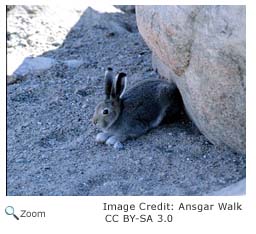 The Arctic hare has long claws, especially on its hind legs. It uses its claws to dig in packed snow. The Arctic hare can hop on its hind legs like a kangaroo at speeds of up to 30 miles an hour! The Arctic hare also has incisors (front teeth) that are longer and straighter than most hares. It uses them to pull plants out from rocky crevices. The Arctic hare has long claws, especially on its hind legs. It uses its claws to dig in packed snow. The Arctic hare can hop on its hind legs like a kangaroo at speeds of up to 30 miles an hour! The Arctic hare also has incisors (front teeth) that are longer and straighter than most hares. It uses them to pull plants out from rocky crevices.
Range 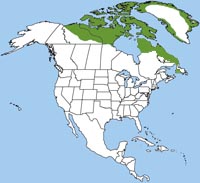 The Arctic hare is found in northern Canada, usually above the tree line and on some islands off Greenland. The Arctic hare is found in northern Canada, usually above the tree line and on some islands off Greenland.
Habitat
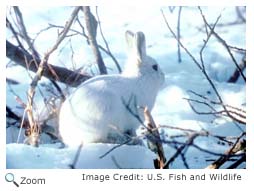 The Arctic hare lives in the tundra and in rocky mountainous areas. It needs a habitat in which plants can grow enough to keep the snow from getting too deep. The Arctic hare lives in the tundra and in rocky mountainous areas. It needs a habitat in which plants can grow enough to keep the snow from getting too deep.
|
|
Diet
The Arctic hare eats mostly woody plants like willow twigs and roots, but it also eats sedges, mosses, and berries.
Life Cycle 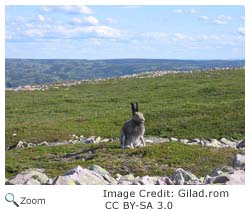 The Arctic hare mates between April and May. Males may box with their front legs over a female. Babies are born in late May through July. Young are born later in the northernmost part of the hare's range. The Arctic hare mates between April and May. Males may box with their front legs over a female. Babies are born in late May through July. Young are born later in the northernmost part of the hare's range.
The female builds a nest in a depression in the ground, usually behind some rocks or behind a bush. She lines it with grass and her fur. She gives birth to between two to eight young. The mother stays with the babies for the first couple of days. The young can protect themselves after that by remaining motionless among the rocks or vegetation, making it hard for predators like the wolf, lynx and Arctic fox to spot them.
When the babies are two to three weeks old, they start to leave the nest and explore their habitat. They will come back to the nest only to nurse. Groups of up to 20 young hares may gather at one time to nurse. They are fully weaned and independent when they are about eight to nine weeks old.
Behavior
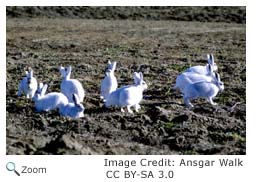 Arctic hares are nocturnal. They often gather in groups of 10-60 hares when they are feeding. In the northernmost parts of their range, they have been known to gather in groups of up to 300! Arctic hares are nocturnal. They often gather in groups of 10-60 hares when they are feeding. In the northernmost parts of their range, they have been known to gather in groups of up to 300!
|




 The Arctic hare is found in northern Canada, usually above the tree line and on some islands off Greenland.
The Arctic hare is found in northern Canada, usually above the tree line and on some islands off Greenland.


